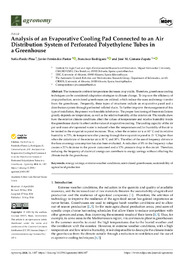Por favor, use este identificador para citar o enlazar este ítem:
https://hdl.handle.net/11000/33462
Analysis of an Evaporative Cooling Pad Connected to an Air Distribution System of Perforated Polyethylene Tubes in a Greenhouse
Título :
Analysis of an Evaporative Cooling Pad Connected to an Air Distribution System of Perforated Polyethylene Tubes in a Greenhouse |
Autor :
Pardo Pina, Sofía
ferrández-pastor, francisco-javier 
Rodriguez, Francisco
Cámara-Zapata, José-María  |
Editor :
MDPI |
Departamento:
Departamentos de la UMH::Física Aplicada |
Fecha de publicación:
2024-05-31 |
URI :
https://hdl.handle.net/11000/33462 |
Resumen :
The increase in ambient temperature decreases crop yields. Therefore, greenhouse cooling techniques can be considered adaptation strategies to climate change. To improve the efficiency of crop production, semi-closed greenhouses are utilized, which reduce the mass and energy transfer from the greenhouse. Frequently, these types of structures include an evaporative panel and a distribution system through perforated inflated ducts. To further improve the management of this type of installation, the present work models its behavior. The proper functioning of these installations greatly depends on temperature, as well as the relative humidity of the exterior air. The results show how the exterior climate conditions affect the values of temperature and relative humidity inside the greenhouse due to its effect on the value of evaporative cooling. The cooling capacity of the air per unit mass of evaporated water is reduced when the temperature and/or humidity of the air to be treated in the evaporative panel increases. Thus, when the exterior air is at 40 °C and its relative humidity is 75%, its temperature after passing through the evaporative panel is 15 °C higher than when the initial state of the exterior air is 30 °C and 30%. The effect of the use of frequency drivers in the fans on energy consumption has also been evaluated. A reduction of 8% in the frequency value causes a 22% decrease in the power consumed and a 15% pressure drop in the circuit. Therefore, reducing the frequency of electrical energy can contribute to energy savings without affecting the climate inside the greenhouse
|
Palabras clave/Materias:
Energy savings
Extreme weather conditions
Semi-closed greenhouses
Sustainability of agricultural production |
Tipo de documento :
info:eu-repo/semantics/article |
Derechos de acceso:
info:eu-repo/semantics/openAccess |
DOI :
https://doi.org/10.3390/agronomy14061187 |
Publicado en:
Agronomy 2024, 14(6), 1187 |
Aparece en las colecciones:
Artículos - Física Aplicada
|
 La licencia se describe como: Atribución-NonComercial-NoDerivada 4.0 Internacional.
La licencia se describe como: Atribución-NonComercial-NoDerivada 4.0 Internacional.
 La licencia se describe como: Atribución-NonComercial-NoDerivada 4.0 Internacional.
La licencia se describe como: Atribución-NonComercial-NoDerivada 4.0 Internacional.
.png)
